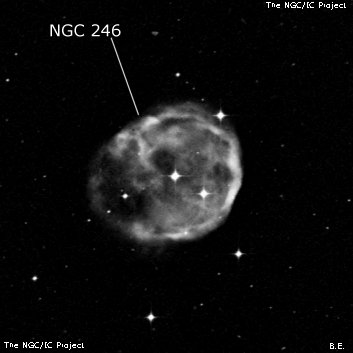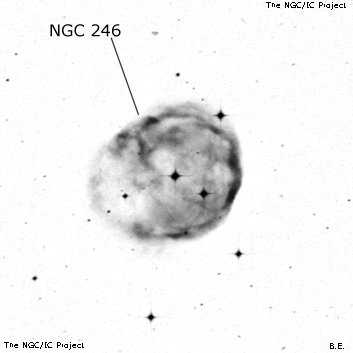NGC/IC Project Restoration Effort
(This is a very very beta version)
NGC246


Basic Information
Location and Magnitude
Right Ascension: 0:47:3.3
Declination: -11:52:17
Constellation: CET
Visual Magnitude: 10.9
Historic Information
Discoverer: Herschel W.
Year of discovery: 1785
Discovery aperture: 18.7
Observational
Summary description: vF, L, 4 st in dif neb
Sub-type: PN
Steve's Notes
=====
NGC 246
48" (10/23/14): At 488x with an NPB filter the view of the Skull Nebula was breathtaking and all the structure in a detailed photograph was visible. The thin brighter rim varied in brightness, thickness and scalloped structure along its entire length.
The rim is brightest along a 60¡ arc on the western side, bulging inward just north of center, creating a small darker indentation in the rim due west of the prominent central star. Moving counterclockwise around the rim, a small brighter, elongated patch is at the northwest edge, close to a mag 11.5 star just outside the planetary. The rim is relatively weak along the north side, but two brighter (detached) patches are along the northeast side. An irregular, elongated luminous patch spreads inward here. This glow is fairly prominent just northwest of center, on line with the central star and the second interior mag 12 star, and a second patch is midway from the central star to the north rim. The rim is weakest overall along a 90¡ arc on the eastern side, near a mag 13.5 star, which is embedded just within the planetary. At the south rim, two more luminous patches are visible with the westernmost glow both larger and brighter.
The interior is relatively dark, though glows weakly with subtle variations, creating pockets of darkness - one is northeast of the central star. A very faint interior glow is just south of the mag 12 star on the southwest side. More extensive faint nebulosity extends inward from the southern rim, though the brightest interior glow is the split nebulosity mentioned earlier on the northwest side.
33" (9/16/07): gorgeous annular planetary viewed at 200x. The thin brighter rim was striking and varied in brightness and thickness around the periphery. The rim is brightest along the western or WNW edge and weakest on the east side. The interior was darker but irregular in surface brightness.
18" (10/13/07): 175x gave an excellent view using the NPB filter and the thin, bright irregular rim (only dimming on the east side) and darker center was quite striking.
18" (8/23/03): I took a quick look at 160x from Chew's Ridge with a thin waning crescent low in the ENE. Without a filter I don't remember the brighter rim being so crisply defined and the annularity so clear. The superimposed stars gave the planetary a transparent, 3-dimensional feel as if I was seeing inside the object.
17.5" (1/8/00): at 100x, appears as a moderately bright, 3.5' irregular glow with a darker center and encompassing four stars including the 12th magnitude central star. Excellent contrast gain using an OIII filter, which sharpens up the edge of the roundish annulus and enhances the irregular surface brightness. The halo is brightest along a 270¡ arc running from SW to NE and is clearly weakest at the east edge of the halo. A mag 11.5 star is embedded at the NW edge of the halo 2.0' from center. The irregular central hole is much darker but faintly luminous. Also superimposed is a mag 12 star SW of the central star and a 4th star is just inside the eastern boundary. The central star forms a thin right triangle with the other two brighter stars. At 220x, the western 90¡ outer arc is brightest and there appears to be a knot embedded at the NE edge of the halo.
17.5" (9/19/87): fairly bright, large, 4' diameter, annular. Four stars are involved including the central star. This planetary has an irregular surface brightness with subtle structure.
13" (11/05/83): fairly bright with filter, clearly annular, sharper edges. NGC 255 lies 15' SSE.
8": fairly faint, large, four stars involved. No annularity noted.
16x80 (8/24/84): faintly visible in finder.
80mm finder (10/13/07): visible unfiltered at 25x. Nice contrast gain using the NPB filter and the planetary also appears to increase in size.



